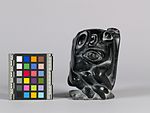Carving
About this object
History of use
Prior to European contact, creating objects for artistic appreciation alone was unknown among the Inuit. Artistic expression was confined to artifacts of utilitarian or spiritual importance. For example, tools used for hunting were carefully crafted to imbue them with spiritual strength and to demonstrate respect for the spirits of the animals these weapons would kill. Contact with outsiders led the Inuit to create small carvings in ivory, stone and bone as items of trade and gifts. Contemporary Inuit sculpture produced for the art market began in the 1950's in response to a very successful sale, by the Canadian Handicraft Guild in Montreal in 1949, of pieces collected by James A. Houston on the east coast of Hudson Bay. Inuit carvings quickly became the official gift choice for visiting dignitaries. The Inuit co-operatives developed by 1959 and a central marketing agency was established in 1965. Carving continues to be a major source of income in the Eastern Canadian Arctic, an area which has undergone major social and economic changes, especially since World War II. There has been a steady growth in permanent settlements during the last half of this century which has made large scale carving in stone feasible. Traditionally, carving materials were mainly bone, antler, and ivory, because of their light weight, strength, and durability. Heavier and more fragile stone was used primarily for lamps and cooking vessels. Although Inuit sculpture is often referred to as 'soapstone' sculpture, in fact, less than half of the stone used is soapstone (a high-grade talc or steatite). Other stones commonly used include serpentine, olivine, periodite, chrysolite, and others. In the early years of the industry it was possible to identify where a carving came from by the specific type of stone used, however, in recent years stone is traded on a wider, regional basis. Whale bone, antler, walrus tusk ivory, and a variety of other materials are also used by Inuit carvers. Themes in Inuit sculpture are based on personal experiences and beliefs, derive from oral traditions, mythology, as well as from narrative and figurative themes depicting arctic fauna and scenes of traditional Inuit life. Regional, community, and individual styles are also apparent.
Narrative
This sculpture won first prize in the Povungnituk Imaginative Carving Exhibition of 1967. This competition was originated by Dr. Nelson Graburn and its primary purpose was to engender or rekindle originality in Inuit carving. The competition rules were that carvings should be 'takushurnaituk' (things never seen before) and 'adjigiingituk' (different from each other). The piece has been referred to as "Man Devoured by Spirit Monster" and as "Man Emerging from Spirit Monster" but neither title appear to have been assigned by the artist, so the piece is untitled at present. The sculpture is from the Balshine Family collection.
Cultural context
contemporary art
Iconographic meaning
Carving represents the world of the unseen.
Physical description
Stylized blocky figure with a large head, large oval rimmed eyes on different angles with bulging centres, curled sideways nose with deep round nostrils between eyes. Small humanoid head is emerging from rimmed, oval sucker-shaped mouth. Series of wrinkles (?) on top. Limbs are folded under and beside head. Arm (?) on right bends up behind and ends in a large fingernail type protrusion. Arm on left bends down and ends in an eye-like oval. Legs below have hoof-like ends and bend to one side. Syllabics and "6654" are inscribed on irregularly-shaped base.
Categories
Materials
